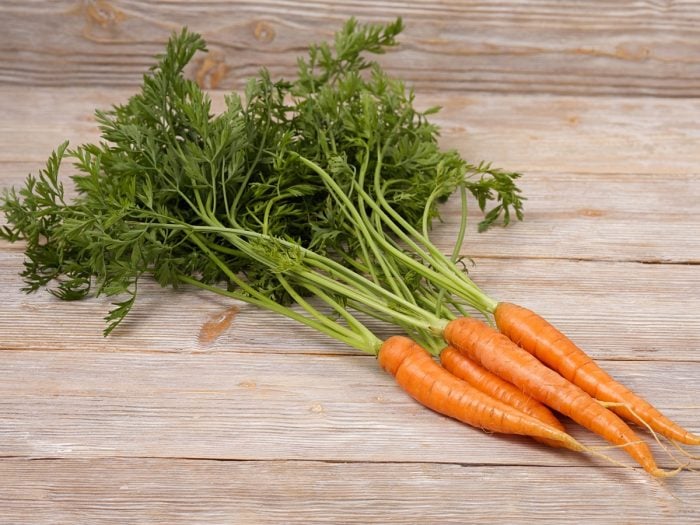Most people chop off carrot greens and throw them in the garbage, but these can be used in a variety of ways, and also offer quite a few nutritional benefits if properly prepared.
What are Carrot Greens?
Carrot greens are the green leaves that grow from the top of the carrot’s taproot. While the root vegetable is what most people cultivate and choose to eat, the greens that emerge above the soil are also edible. In the past, there was a widespread belief that these greens were toxic, but this is likely due to their bitter flavor. Humans tend to associate bitterness with toxicity, but as it turns out, these greens are edible and do not pose a threat to health. Due to their bitterness, however, they are rarely considered for consumption.
Carrot greens tend to be leafy and delicate, and also have a fibrous taste when consumed. Their flavor is paired nicely with something sweet, and they can also be blanched to soften the flavor. These greens have long been ignored, but given how versatile and packed with nutrients they are, many people are beginning to utilize these greens in their cooking. [1]
Carrot Greens Nutrition
Carrot greens contain an impressive list of nutrients, including significant amounts of vitamin A, dietary fiber, vitamin C, calcium, and iron. There is no fat or cholesterol in these greens, and there are roughly 90 calories in 1 cup of these raw greens. These greens also contain vitamin K and various phenolic compounds and carotenoids, along with trace amounts of other antioxidants. [2]
Carrot Greens Health Benefits
The top benefits of these greens include their healthy impact on the immunity, bone density, eye health, circulation, kidney function, blood pressure, and digestion, among others.
May Help Boost Immune System
With known detoxifying properties, vitamin C, and may have a significant level of antioxidants, carrot greens can help to give your immune system a boost, protecting your body against infections and foreign pathogens. [3]
May Improve Vision
Similar to carrots themselves, the greens from this vegetable are also potentially high in certain antioxidants, like lutein, zeaxanthin, and beta-carotene. These compounds can help protect your retina from oxidative stress, while also lowering your risk of macular degeneration and cataracts. [4]
May Eliminate Toxins
Studies have shown that the active ingredients in carrot greens are able to quickly eliminate toxins in the body and optimize kidney health.

Carrot greens can be added to salads and soups. Photo Credit: Shutterstock
May Regulate Blood Pressure
These greens are very high in potassium, which functions as a vasodilator in the body. This can help reduce the tension and strain in the blood vessels and arteries, thus relieving strain on the cardiovascular system. [5]
May Improve Bone Density
Although there aren’t as many minerals in carrot greens as the taproot, the various minerals can all contribute to bone mineral density and lower your risk of osteoporosis as you age. [6]
May Aid in Digestion
The greens from a carrot can help to optimize digestion thanks to the significant level of dietary fiber, which can stimulate peristaltic motion and improve nutrient uptake efficiency in the gut. [7]
Uses for Carrot Greens
You can use carrot greens for a number of things in the kitchen, primarily as salad greens. Due to the bitter nature of the greens, however, it is best to pair this with other sweeter ingredients, or at least a vinaigrette of some kind. You can also use these greens as a pureed topping on carrot soup, or you can mix these greens into couscous, hummus, pesto or chickpea salads. These greens are great in stir-frys and curries and are also a popular garnish in certain cultures. Blanching the carrot greens, by soaking them in boiling water for a few minutes, can help to reduce the bitter flavor and make them more palatable in meals. [8]
Medicinally speaking, carrot greens have been used in vegetable shakes and juices for their dense nutritional quality. These greens have also been used in poultices and salves in traditional medicine for generations. Carrot greens have been blended into mouthwashes or as a topical wound-cleaning cream.
How to Store Carrot Greens?
Once you pick carrots from the ground, the inevitable process of wilting will begin for the carrot greens. The best way to store carrot greens, if you intend to cook with them, is to blanch the greens (place them in boiling water for 2-3 minutes, then cool them immediately). Following that, you can thoroughly dry the greens, or wrap them in a paper towel in a plastic bag, and then store them in the refrigerator. The greens should keep for up to a week, but the sooner you use these greens, the better, as they are prone to wilting rather rapidly.
How To Sautée Carrot Greens?
One of the best ways to cook these greens and remove some of the bitterness is to sauté them!
Step 1 – Clean the carrot greens thoroughly.
Step 2 – Blanch the carrot greens in a sauté pan.
Step 3 – Add 2 teaspoons of olive oil to the pan, along with salt and pepper.
Step 4 – Sauté the greens for 2-3 minutes, until they begin to brown.
Step 5 – Add lemon juice, cook for another 1 minute, then serve hot.
